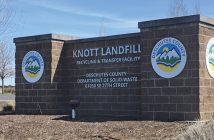As the last full weekend of January 2015 drew to a close, skiers at Mt. Bachelor experienced spring skiing conditions, with bright sun, record high temperatures and soft snow. Meanwhile, Oregon’s legislative leaders prepared for the start of the 2015 legislative session. Recently, as many legislators passed through the Cascades on their way to Salem, they saw the impacts that unseasonably warm, dry weather has had on the dwindling mountain snowpack.
With an average rainfall of only about 12 inches, water is the lifeblood of Central Oregon. We are fortunate to have deep mountain snow in most years that provides flow for our rivers and groundwater systems late into the summer months. This natural reservoir provides a steady supply of water for irrigation, aquatic ecosystems and cities.
A lack of winter snow can stretch the region’s water supply to the limit. Our priority-based Oregon water rights laws dictate that during times of shortage, junior water rights holders must go without water. This harsh result can create economic challenges for Central Oregon businesses that rely on a reliable supply of water for both consumptive and instream uses.
As we near the start of the 2015 state legislative session, Oregon’s Governor has proposed a budget directing $50 million toward state-wide water supply investment. This includes possible funding for new water storage projects, as well as water conservation investments such as the piping projects that have been undertaken by many of Central Oregon’s irrigation districts. These projects have resulted in more efficient irrigation deliveries, new hydropower generation, water for cities, instream flow enhancements and jobs.
The Governor’s proposed investment to help secure Oregon’s water future comes on the heels of similar investments by Washington ($250 million) and California ($7 billion). And while it is a minor sum by comparison, the proposed investment would be a good second step to build on groundbreaking Oregon legislation in 2013 (Senate Bill 839).
Senate Bill 839 represented the State’s first significant investment in water resources development in years. The Deschutes Basin was a direct beneficiary, securing funds to undertake a water planning study in partnership with the U.S. Bureau of Reclamation. That basin study is now underway, with the goal to identify future consumptive and instream water needs of the basin as well as ways in which to supply those needs in the face of a changing climate.
By contrast, in 2015, the initial budget put forward by Oregon’s legislative leaders does not reflect the Governor’s priorities for investment in a sustainable water future. This difference in priorities will be resolved by the end of the 2015 legislative session. To ensure it is resolved in our favor, it is critical that the business community engage with the legislature to make sure our elected leaders understand how important a secure water supply is to our future prosperity.
Steve Shropshire is a member of Jordan Ramis PC’s Dirt Law practice group, and manages the firm’s Central Oregon office.
This article is intended to inform the reader of general legal principles applicable to the subject area. It is not intended to provide legal advice regarding specific problems or circumstances. Readers should consult with competent counsel with regard to specific situations.





